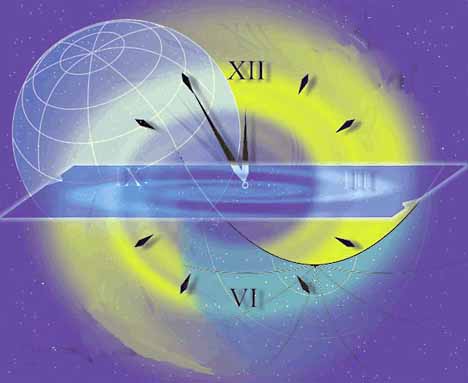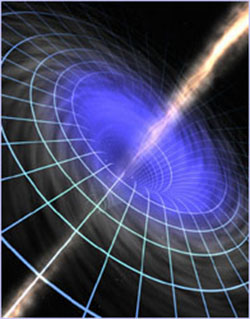

Time is a part of the measuring system used to sequence events, to compare the durations of events and the intervals between them, and to quantify rates of change such as the motions of objects. The temporal position of events with respect to the transitory present is continually changing; events happen, then are located further and further in the past. Time has been a major subject of religion, philosophy, and science, but defining it in a non-controversial manner applicable to all fields of study has consistently eluded the greatest scholars. A simple definition states that "time is what clocks measure".
Time is one of the seven fundamental physical quantities in the International System of Units. Time is used to define other quantities - such as velocity - so defining time in terms of such quantities would result in circularity of definition. An operational definition of time, wherein one says that observing a certain number of repetitions of one or another standard cyclical event (such as the passage of a free-swinging pendulum) constitutes one standard unit such as the second, is highly useful in the conduct of both advanced experiments and everyday affairs of life. The operational definition leaves aside the question whether there is something called time, apart from the counting activity just mentioned, that flows and that can be measured. Investigations of a single continuum called spacetime bring questions about space into questions about time, questions that have their roots in the works of early students of natural philosophy.
Two contrasting viewpoints on time divide many prominent philosophers. One view is that time is part of the fundamental structure of the universe, a dimension in which events occur in sequence. Sir Isaac Newton subscribed to this realist view, and hence it is sometimes referred to as Newtonian time.
Time travel, in this view, becomes a possibility as other "times" persist like frames of a film strip, spread out across the time line. The opposing view is that time does not refer to any kind of "container" that events and objects "move through", nor to any entity that "flows", but that it is instead part of a fundamental intellectual structure (together with space and number) within which humans sequence and compare events. This second view, in the tradition of Gottfried Leibniz and Immanuel Kant,holds that time is neither an event nor a thing, and thus is not itself measurable nor can it be travelled.
Temporal measurement has occupied scientists and technologists, and was a prime motivation in navigation and astronomy. Periodic events and periodic motion have long served as standards for units of time. Examples include the apparent motion of the sun across the sky, the phases of the moon, the swing of a pendulum, and the beat of a heart. Currently, the international unit of time, the second, is defined in terms of radiation emitted by caesium atoms. Time is also of significant social importance, having economic value ("time is money") as well as personal value, due to an awareness of the limited time in each day and in human life spans.
Ray Cummings, an early writer of science fiction, wrote in 1922, "Time... is what keeps everything from happening at once", a sentence repeated by scientists such as C. J. Overbeck, and John Archibald Wheeler. Below are three current articles having to do with the concept of Time.
Perpetual Motion 'Time Crystals' May Exist, Physicist Says Live Science - February 22, 2012
From diamonds to snowflakes to salt, crystals are common in nature. The arrangement of their atoms in orderly, repeating patterns extending in all three spatial dimensions doesn't just make them nice to look at; crystals are also the vital components of technologies from electrical transistors to LCD screens. In groundbreaking new research, Nobel-winning physicist Frank Wilzcek contends that "time crystals," moving structures that repeat periodically in the fourth dimension, exist as well. A time crystal would be a physical object whose constituent parts move in a repeating pattern. Think of a kaleidoscope, whose sparkly bits swirl on loop forever, or a clock, whose hour hand completes a 360-degree turn every 12 hours. But unlike clocks or other common objects with moving parts, time crystals would run forever under their own steam - perpetual motion devices permitted by the laws of physics.
Sudden cardiac death: Time of day link found in mice BBC - February 23, 2012
How the time of day can increase the risk of dying from an irregular heartbeat has been identified by researchers. The risk of "sudden cardiac death" peaks in the morning and rises again in the evening. A study published in the journal Nature suggests that levels of a protein which controls the heart's rhythm fluctuates through the day. A body clock expert said the study was "beautiful".
Body's 'Doomsday Clocks' Count Down to Death, or Cancer Live Science - February 23, 2012
Every cell in your body has its own Doomsday Clock, ticking down the number of times it can safely divide. This clock takes the form of a cap on the ends of each chromosome, called a telomere. Like the plastic aglets on the tips of shoelaces, telomeres keep the chromosome from fraying. However, they get shorter every time the cell splits.When the telomeres have shrunk to a certain point, the cell can go one of two ways. ItŐs supposed to die. But in the case of cancer, the cell keeps living. If scientists could make drugs to control telomeres, they could perhaps treat diseases of aging as well as cancer.
